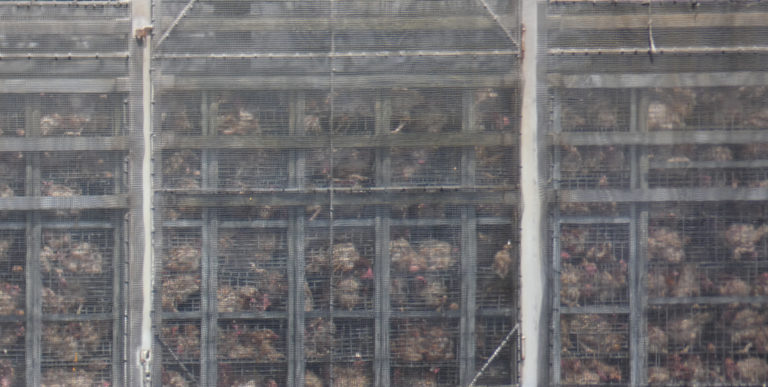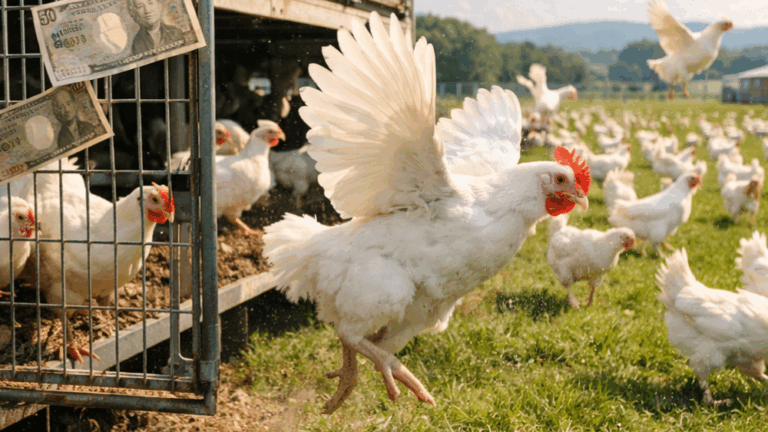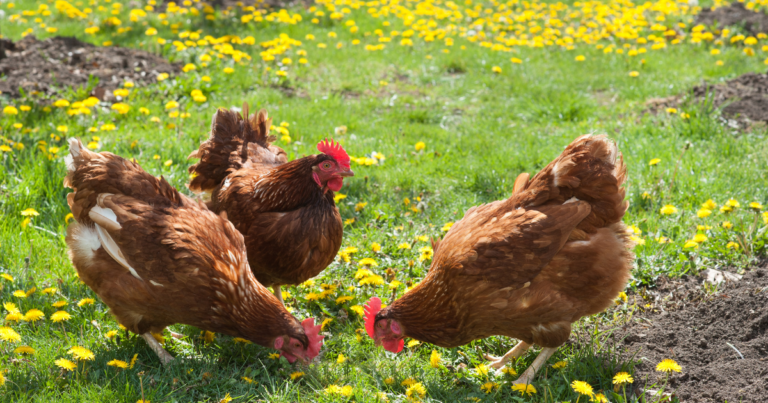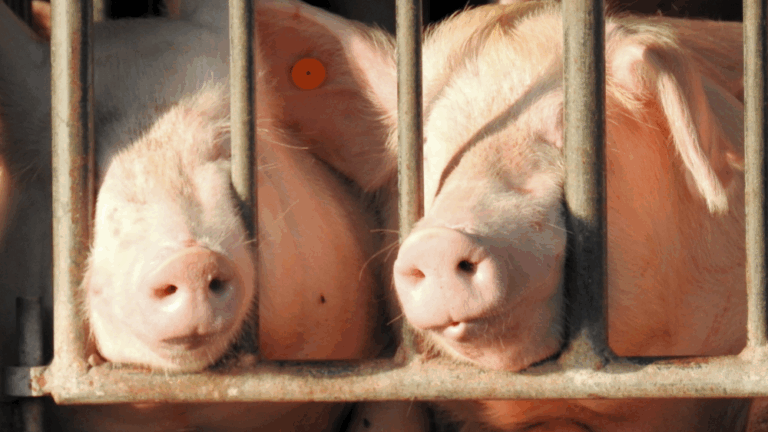We’ve been following the issue of egg laying hens being abandoned for long hours at slaughterhouses since 2018.Unlike broiler chickens, egg laying hens have to wait overnight until they are killed at slaughterhouses. It’s a big animal welfare issue since chickens are not able to move their heads in a tiny cage for these hours. It was discussed in the diet and ultimately led to concerned ministries to release improvement notices.
However, the Animal Rights Center confirmed the situations hadn’t improved so it was escalated in the diet again. As a result, the Ministry of Health, Labor, and Welfare finally conducted an on-site inspection in August 2018.
Their finding was released in November 2018, which demonstrated the fact half of birds are abandoned for longer than 12 hours at a slaughterhouse. This doesn’t include the transportation period so the confinement actually lasts longer than 12 hours.
The result also revealed some were confined in a cage for as long as 4 days.
| Waiting Period | Number of Lots |
| Within 3 hours | 87 |
| 3 – 6 hours | 13 |
| 6 – 12 hours | 12 |
| 12 – 24 hours | 71 |
| 24 to 48 hours | 25 |
| 48 to 72 hours | 3 |
| Over 72 hours | 2 |
| Unknown | 5 |
| Total | 218 |
Based on the results, another improvement notice was issued again in March 2019.
Has there been any change since then?
Has the situation improved?
The Animal Rights Center conducted our own inspection after the improvement notice was issued in March 2019. The result revealed the hens have to spend overnight at all the slaughterhouses, except for one facility:
Facility A: Nov 14th 2019, hens were abandoned overnight
Facility B: Nov 14th 2019, hens were abandoned overnight
Facility C: August 21st 2019, Dec 26th 2019, hens were abandoned overnight
Facility D: August 21st 2019, Dec 26th 2019, hens were abandoned overnight
Facility E: Dec 26th 2019, hens were abandoned overnight
Facility F: Dec 26th 2019, no hens were abandoned overnight
Inspection in 2020
The single inspection may not give a full picture so we started to investigate 3 more slaughterhouses on a regular basis in 2020.
The results are shown below:
*Red line indicates the facility was closed. We inspected around 5 pm on weekdays and noon on days the facility was closed.
Facility G
| Year | month | Date | Day | Wait time |
| 2020 | 3 | 9 | Mon | ○ |
| 2020 | 3 | 10 | Tue | ○ |
| 2020 | 3 | 11 | Wed | ○ |
| 2020 | 3 | 12 | Thu | ○ |
| 2020 | 3 | 13 | Fri | ○ |
| 2020 | 3 | 14 | Sat | × |
| 2020 | 3 | 15 | Sun | ○ |
| 2020 | 3 | 16 | Mon | ○ |
| 2020 | 3 | 17 | Tue | ○ |
| 2020 | 3 | 18 | Wed | ○ |
| 2020 | 3 | 19 | Thu | × |
| 2020 | 3 | 20 | Fri | ○ |
| 2020 | 3 | 21 | Sat | ○ |
| 2020 | 3 | 22 | Sun | ○ |
| 2020 | 3 | 23 | Mon | ○ |
| 2020 | 3 | 24 | Tue | ○ |
| 2020 | 3 | 25 | Wed | ○ |
The results show that the hens have to spend overnight if the following day is a business day.
Additionally, they transported hens on March 21st even though the following day was closed. They needed to wait in a tiny cage for two days until they were slaughtered.
Facility H
| Year | month | Date | Day | Wait time |
| 2020 | 3 | 8 | Sun | ○ |
| 2020 | 3 | 9 | Mon | ○ |
| 2020 | 3 | 10 | Tue | ○ |
| 2020 | 3 | 11 | Wed | ○ |
| 2020 | 3 | 12 | Thu | ○ |
| 2020 | 3 | 13 | Fri | × |
| 2020 | 3 | 14 | Sat | × |
| 2020 | 3 | 15 | Sun | ○ |
| 2020 | 3 | 16 | Mon | ○ |
| 2020 | 3 | 17 | Tue | ○ |
| 2020 | 3 | 18 | Wed | ○ |
| 2020 | 3 | 19 | Thu | × |
| 2020 | 3 | 20 | Fri | × |
| 2020 | 3 | 21 | Sat | × |
| 2020 | 3 | 22 | Sun | ○ |
| 2020 | 3 | 23 | Mon | ○ |
| 2020 | 3 | 24 | Tue | ○ |
The results show the hens have to wait overnight if the following day is a business day in this facility as well.
Facility I
| Year | month | Date | Day | Wait time |
| 2020 | 3 | 12 | Thu | ○ |
| 2020 | 3 | 13 | Fri | × |
| 2020 | 3 | 14 | Sat | × |
| 2020 | 3 | 15 | Sun | ○ |
| 2020 | 3 | 16 | Mon | ○ |
| 2020 | 3 | 17 | Tue | ○ |
| 2020 | 3 | 18 | Wed | ○ |
| 2020 | 3 | 19 | Thu | ○ |
| 2020 | 3 | 20 | Fri | ○ |
| 2020 | 3 | 21 | Sat | × |
| 2020 | 3 | 22 | Sun | × |
| 2020 | 3 | 23 | Mon | ○ |
| 2020 | 3 | 24 | Tue | ○ |
| 2020 | 3 | 25 | Wed | ○ |
| 2020 | 3 | 26 | Thu | ○ |
This facility kept the hens overnight if the following day was a business day, except for March 22.
As far as these results demonstrate, there aren’t really efforts to improve the situations for hens at slaughterhouses.
There are 110 broiler chicken slaughterhouses while there are only 31 for egg laying hens, so there are fewer slaughterhouses for hens. That said, it seems extreme for these hens to wait for such long hours given the fact 100 million egg laying hens are slaughtered every year compared to 600 million broiler chickens.
What about the companies that raise these hens?
One of the reasons the Ministry of Health and Welfare and Labor pointed out in the investigation was that the companies that raise hens are uncooperative.
It makes sense since the situation can’t simply be improved after a single effort to make change to these slaughterhouses.
There are only 31 facilities across the country so vendors have to drive long distances.
On top of that, tens of thousands of birds are shipped off all at once for efficiency as farms are increasing in size.
Additionally, it’s easy to assume chicken farms may plan to ship their hens at the most profitable times because they receive subsidies if they empty the cages to renew, meaning slaughter, adult hens.
If the timing is right, the farmers receive 210 yen for every chicken they send to slaughter.
It’s understandable the shipments are timed for that reason, but it should not justify their lack of animal welfare awareness.
The Animal Rights Center conducted further hearings with 7 chicken companies in 2020 since the situation has not been improved:
Company A: We have established a system in which we don’t have to keep chickens too long until they get slaughtered.
Companies B and C: We have a system in which we work together with the slaughterhouses so we can avoid keeping chickens too long.
JA Z Tamago.Co.,Ltd, who distributes eggs from numerous farmers: No comment in regards to hens being abandoned for long hours or whether or not they ask farmers to avoid doing so. They only stated they were compliant.
Itochu Feed Mills, Yachiyo Poultry, Akita Foods: They did not provide any answers.
At least 3 companies were aware of animal welfare issues, and demonstrated they would work together with slaughterhouses.
However, the other 4 companies either didn’t provide clear answers or they didn’t respond even with multiple requests. Considering it’s been 2 years since the ministries issued the improvement notice, we must say their commitment is very low. That said, we can’t only blame these companies. It’s partially our fault, too. We must raise more awareness.There are about 2000 egg laying hen companies in the country so we shall continue to work hard to reach out to them.
Request to Consumers
We request consumers to consider reducing your consumption of eggs. If possible, please stop eating them. Know there is no problem in regards to nutrition if we don’t consume eggs. Ultimately, what it comes down to is there are too many egg laying hens.
Japan ranks 2nd in the world for egg consumption per capita. On average, each person consumes 337 eggs every year. There is no doubt the suffering of these hens would mitigate if we were to reduce the consumption to 1 egg per week.
One other thing we can do is to voice our opinions to relevant ministries. It’s been two years since the Ministry of Health, Labour, and Welfare, the Ministry of Agriculture, Forestry, and Fisheries, and the Ministry of Environment have released an improvement notice.
As a citizen, we should keep pinning to discontinue the poor practice to raise animal welfare awareness.
See below for the information about who you can contact to voice your opinions:
The Ministry of Environment (*relevant field is “7. Nature, Environment, Natural Parks): https://www.env.go.jp/moemail/
The Ministry of Health, Labour, and Welfare: https://www.mhlw.go.jp/form/pub/mhlw01/getmail
The Ministry of Agriculture, Forestry, and Fisheries: https://www.contactus.maff.go.jp/voice/sogo.html
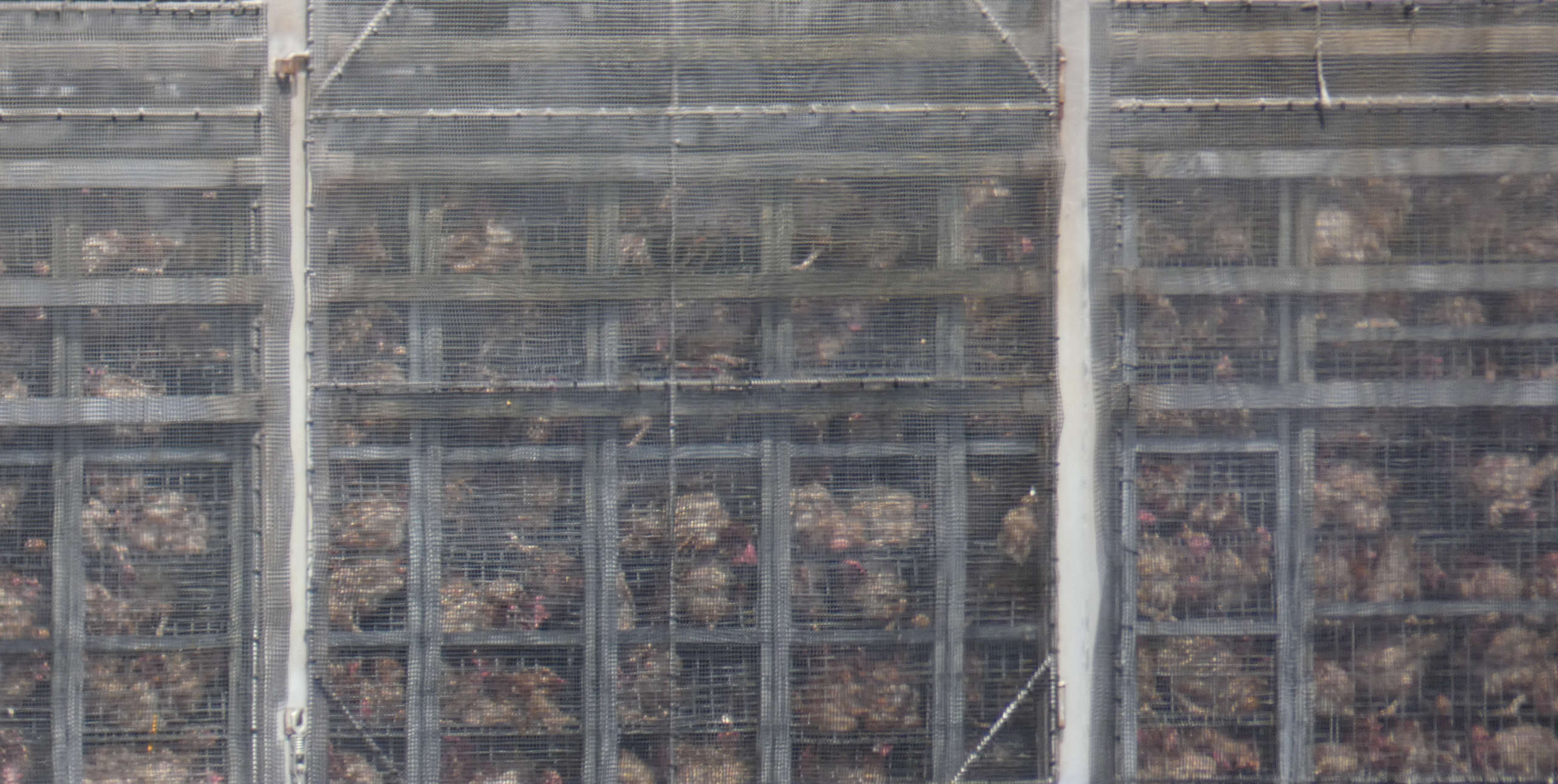
Chickens kept for two nights before they get slaughtered
Translated by Seika K


